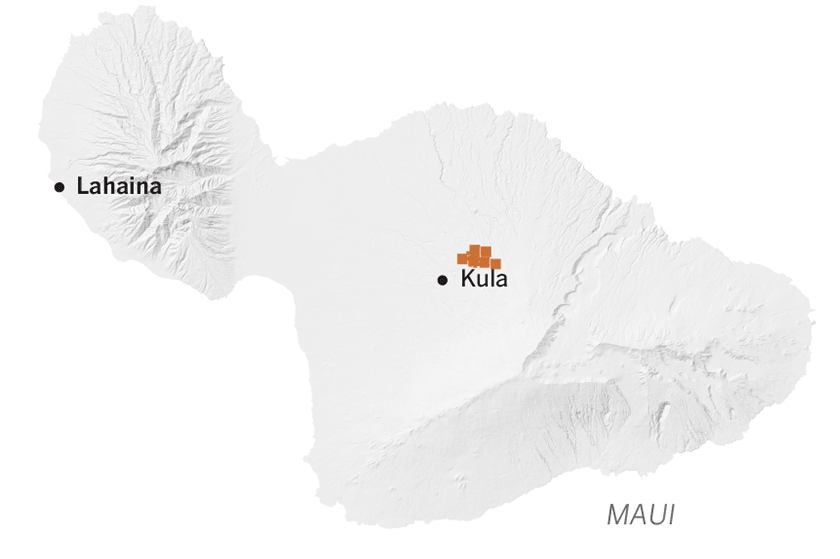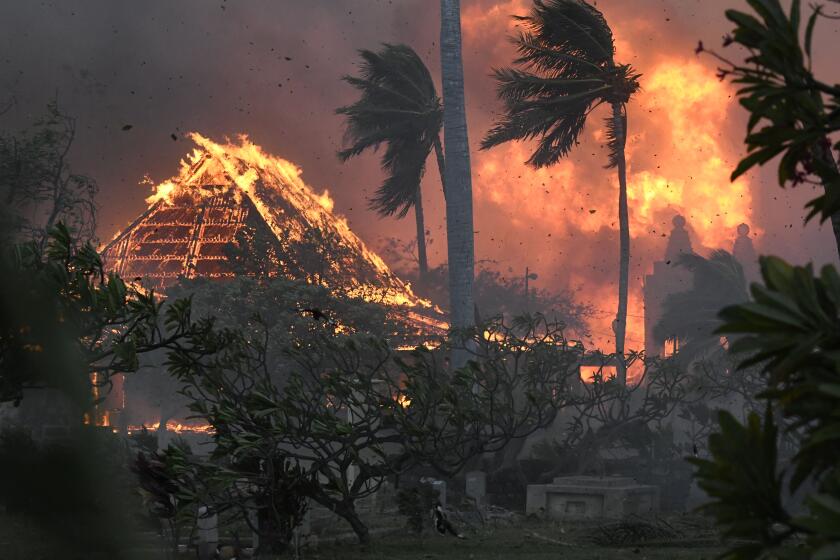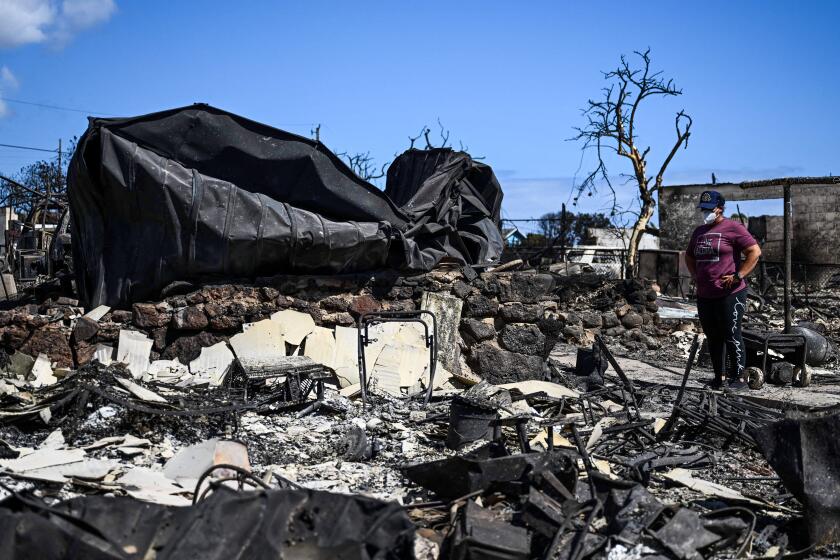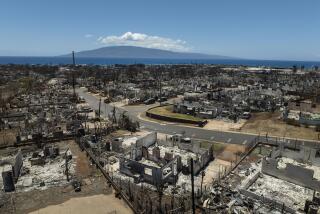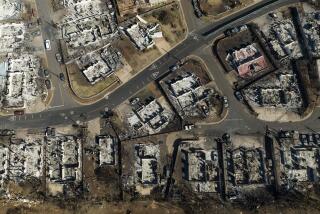With 106 dead and 1,300 unaccounted for, Maui braces for more heartbreaking news
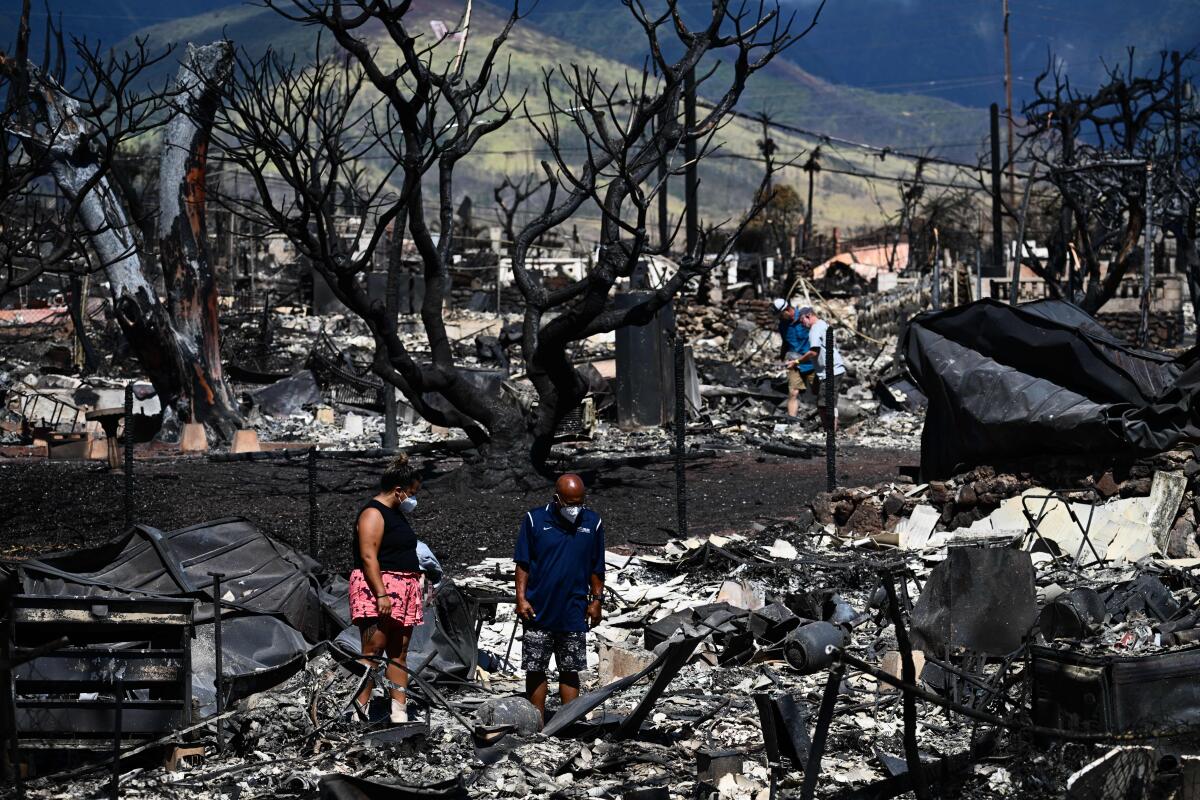
- Share via
With 106 people confirmed dead and about 1,300 still unaccounted for, Maui braced for more heartbreaking losses as officials continued to search for fire victims.
Tons of equipment and supplies arrived in Hawaii on Tuesday to facilitate efforts to process and identify victims, including a portable morgue unit deployed when a disaster spurs more fatalities than can be handled locally.
Maui authorities on Tuesday will begin releasing the names of some of the people who died in the Lahaina fire a week after the ferocious blaze incinerated the historic town in what has become the nation’s deadliest wildfire in a century.
Officials said Tuesday the death toll had climbed to 106 and was expected to rise. About 30% of the burn area has been searched. More than 90 workers with the Federal Emergency Management Agency and 20 cadaver dogs were leading the search through the ash and rubble, authorities said.
About 1,300 people are still unaccounted for, Hawaii Gov. Josh Green said Monday. Crews are likely to find the remains of 10 to 20 people each day until search efforts cease, the governor said, which he estimated could take 10 days. The governor told “CBS Evening News” on Monday night that the remains of the first 80 victims were found in their cars or the surrounding water.
Four of the victims have been identified, the county of Maui said Tuesday. At least three were ID’d using fingerprints. Officials have urged families looking for loved ones to submit DNA swabs to assist with the identification process.
Along with the portable morgue, 22½ tons of supplies and equipment needed for victim identification and processing of remains arrived, including lab and X-ray equipment, said Jonathan Greene, an official with the U.S. Department of Health and Human Services’ Administration for Strategic Preparedness and Response.
The Lahaina fire in West Maui ignited as firefighters focused on the Upcountry fire. What happened next — the deadliest U.S. wildfire in more than a century — left the historic town in ashes.
The Lahaina fire was 85% contained Monday night, officials said. Maui County Fire Chief Bradford Ventura said helicopters would fly along the fire’s perimeter, which had mostly cooled, Tuesday morning looking for hot spots.
More than 2,700 structures were destroyed — the majority of them Lahaina residences. Damage was estimated at $5.6 billion. Moody’s analytics estimates the economic loss at $7 billion, with most of that property damage, and up to $1 billion reflecting lost output.
Green warned residents to beware of real estate developers swooping in to scoop up property from the ruined neighborhoods and exploit local homeowners with lowball deals and cash offers. He said he had asked Hawaii’s attorney general to look into creating a temporary moratorium on buying or selling property damaged in the fires.
The Hawaiian Islands do see wildfire from time to time, but the catastrophic Maui fires were spawned by a striking mix of factors, including climate change.
About 2,000 people remained without power Monday night on West Maui, according to Shelee Kimura, CEO of Hawaiian Electric, which provides service to 95% of the state. The company is facing scrutiny for its failure to preemptively shut off power as dangerous winds stirred up by Hurricane Dora blasted the island.
The practice, called a public safety power shutoff, is common in many states, including California. Utilities may temporarily turn off power to specific areas to reduce the risk of fires caused by electric infrastructure.
When asked why Hawaiian Electric did not shut off power, Kimura said: “It’s still in the early days; we’re still looking at all the information.”
She said the power shut-off programs are “controversial” even in states where they are used, and the practice is “not universally accepted.”
As Hawaii begins to tally the damage and assess how to improve its safety procedures to address extreme fire weather, California can offer many lessons.
The company already is facing two class-action lawsuits from Maui residents alleging it did not cut off power early enough after severe weather notices were issued.
Hawaiian Electric spokesperson Darren Pai declined to comment on the lawsuits. “Our immediate focus is on supporting emergency response efforts on Maui and restoring power for our customers and communities as quickly as possible,” Pai wrote in an email to The Times.
Authorities have not determined the cause of the fire but have said hurricane-force winds fanned the flames, pushing them to travel one mile per minute. Green ordered the state’s attorney general to investigate the fire and how prepared the state was to handle the disaster.
About 3,200 people had signed up for FEMA disaster assistance by late Monday afternoon, said Jeremy Greenberg, the agency’s director of operations for response and recovery. Some who were displaced by the fire are staying in hotels paid for by the government, Greenberg said. Airbnb and other rental groups also are providing housing.
The support comes as tensions over recovery efforts grow, with many in West Maui criticizing what they call a slow government response. Access to Lahaina has been restricted since Green initially announced last week that residents could return to certain areas during designated hours. But constraints have expanded, frustrating residents who say they are desperate to assess the damage to their homes and gather any belongings that were not destroyed.
Lahaina and Upper Kula, a rural area where a fire broke out last week, remain under a water advisory. Survivors who stayed behind have criticized the government’s distribution of critical supplies. Many say they are relying on local groups and volunteers to fill the gaps.
The Maui Police Department suspended a placard program that allowed access to those with proof of residency, hotel workers and first responders hours after launching it Sunday, citing a flood of “nonessential individuals” and nonresidents in the areas that had been opened.
More to Read
Sign up for Essential California
The most important California stories and recommendations in your inbox every morning.
You may occasionally receive promotional content from the Los Angeles Times.
